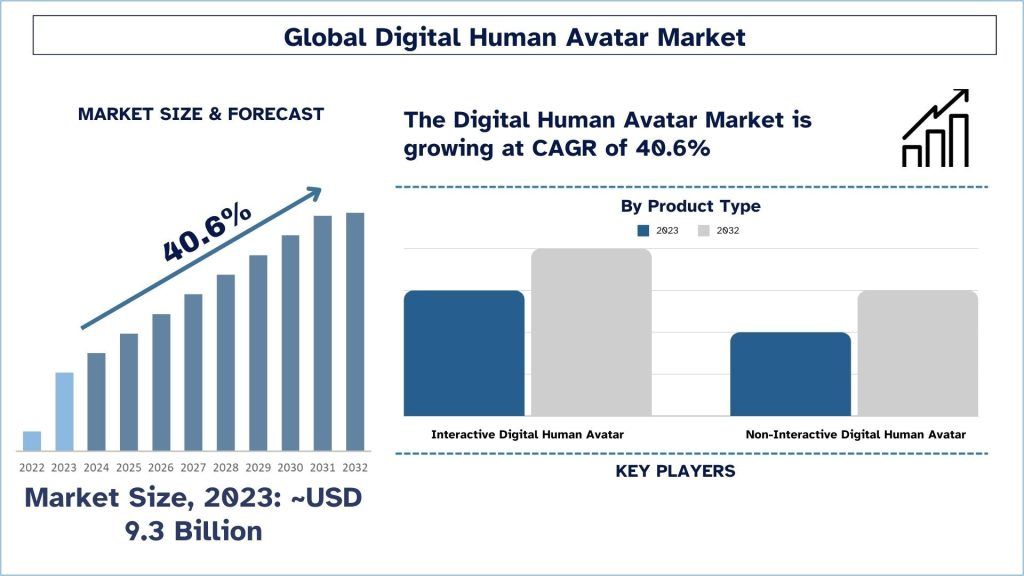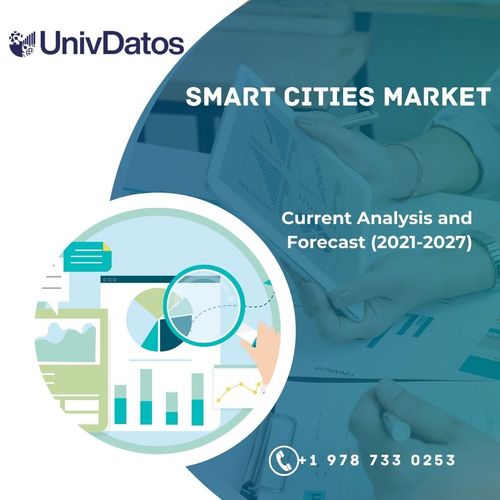- Home
- Chi siamo
- Settore
- Servizi
- Lettura
- Contattaci
Mercato degli Avatar Umani Digitali: Analisi e Previsioni Attuali (2024-2032)
Enfasi sul tipo di prodotto (Avatar Umano Digitale Interattivo e Avatar Umano Digitale Non Interattivo); Implementazione (Basata su Cloud e On-premise); Verticali (Gaming, Retail, IT e Telecomunicazioni, Istruzione e Altri); e Regione/Paese
 Dimensioni e Previsioni del Mercato Globale degli Avatar Umani Digitali
Dimensioni e Previsioni del Mercato Globale degli Avatar Umani Digitali
Il mercato globale degli avatar umani digitali è stato valutato a ~USD 9,3 miliardi nel 2023 e si prevede che crescerà a un forte CAGR di circa ~40,6% durante il periodo di previsione (2024-2032). Ciò è dovuto allo sviluppo di avatar in grado di operare senza problemi su diverse piattaforme e ambienti virtuali.
Analisi del Mercato Globale degli Avatar Umani Digitali
Il mercato degli avatar umani digitali sta crescendo rapidamente poiché le organizzazioni sono alla ricerca di nuove opportunità per creare rappresentazioni digitali efficaci. Questi avatar agiscono come agenti virtuali in grado di simulare azioni e sentimenti umani, rendendo innovative le esperienze degli utenti in settori come i giochi, gli eventi virtuali e l'e-learning. Grazie al crescente utilizzo di varie tecnologie come la realtà aumentata, l'intelligenza artificiale e la modellazione 3D, gli avatar sul mercato sono altamente interattivi con una buona grafica. Inoltre, la comunicazione digitale è diventata più popolare nell'era recente e la realtà virtuale/aumentata è in aumento; gli avatar digitali sono diventati strumenti importanti per la comunicazione narrativa, il coinvolgimento dei clienti e la creazione di uno spazio immersivo nel mondo digitale.
Tendenze del Mercato Globale degli Avatar Umani Digitali
Questa sezione discute le principali tendenze del mercato che stanno influenzando i vari segmenti del mercato globale degli avatar umani digitali, come identificato dal nostro team di esperti di ricerca.
On-premiseSegmento che Trasforma l'Industria
Il segmento on-premise ha anche un grande impatto sul mercato degli avatar umani digitali in quanto offre alle aziende più punti di controllo sui propri dati, sulla sicurezza e sulla flessibilità per la personalizzazione. Le aziende che implementano Avatar Umani Digitali on-premise hanno la flessibilità di implementare le esigenze organizzative e gli standard di conformità per offrire una migliore esperienza utente, mantenendo al contempo i dati critici sicuri e puliti. Questo segmento è di particolare interesse per settori come la sanità, la finanza e l'istruzione, dove la protezione dei dati è di maggiore importanza. Inoltre, la compatibilità delle soluzioni on-premise per lavorare a stretto contatto con altri sistemi migliora anche la funzionalità, senza dimenticare che funziona al meglio per garantire una funzionalità ottimale, aumentando quindi l'adozione e gli investimenti in avatar umani digitali in diversi settori.
![]()
Si prevede che l'Asia-Pacifico crescerà al CAGR più veloce durante il periodo di previsione.
Il mercato degli avatar umani digitali in Asia-Pacifico si riferisce alla creazione e all'implementazione di esseri umani sintetici con intelligenza artificiale e interfacce grafiche migliorate per scopi diversi come il coinvolgimento dei clienti, i giochi, la medicina e l'insegnamento. Questo mercato è costituito da avatar digitali progettati per interagire con gli utenti in modi completamente umani, il che è fondamentale per creare esperienze migliori e automatizzare vari processi. I fattori trainanti sono le crescenti aspettative dei clienti per approcci individuali, lo sviluppo di soluzioni di intelligenza artificiale e machine learning, l'accelerazione degli investimenti nella realtà virtuale e aumentata e l'amplificazione degli avatar digitali in settori come i giochi e i negozi online. Inoltre, a causa della pandemia di COVID-19, l'accettazione da parte dei consumatori della comunicazione remota e delle soluzioni digitali porta a un'ulteriore espansione del mercato poiché le aziende cercano modi per interagire con i consumatori online.
![]()
Panoramica del Settore degli Avatar Umani Digitali Globali
Il mercato globale degli avatar umani digitali è competitivo, con diversi attori del mercato globale e internazionale. I principali attori stanno adottando diverse strategie di crescita per migliorare la loro presenza sul mercato, come partnership, accordi, collaborazioni, lanci di nuovi prodotti, espansioni geografiche e fusioni e acquisizioni. Alcuni dei principali attori che operano nel mercato sono Alibaba Cloud; UneeQ; HOUR ONE AI; iFLYTEK Corporation; Meta Platforms, Inc.; Microsoft Corporation; Soul Machines; Ziva Dynamics; AI Foundation; e NVIDIA Corporation
Copertura del Rapporto sul Mercato Globale degli Avatar Umani Digitali
![]()
Motivi per acquistare questo rapporto:
- Lo studio include l'analisi delle dimensioni del mercato e delle previsioni convalidate da esperti chiave del settore autenticati.
- Il rapporto esamina brevemente le prestazioni complessive del settore a colpo d'occhio.
- Il rapporto copre un'analisi approfondita dei principali attori del settore con un focus primario sulle principali finanze aziendali, sui portafogli di tipi, sulle strategie di espansione e sugli sviluppi recenti.
- Esame dettagliato di fattori trainanti, vincoli, tendenze chiave e opportunità prevalenti nel settore.
- Lo studio copre in modo completo il mercato in diversi segmenti.
- Analisi approfondita a livello regionale del settore.
Opzioni di Personalizzazione:
Il mercato globale degli avatar umani digitali può essere ulteriormente personalizzato in base alle esigenze o a qualsiasi altro segmento di mercato. Oltre a ciò, UMI comprende che potresti avere le tue esigenze aziendali, quindi sentiti libero di contattarci per ottenere un rapporto che si adatti completamente alle tue esigenze.
Indice
Metodologia di Ricerca per l'Analisi del Mercato Globale degli Avatar Umani Digitali (2024-2032)
L'analisi del mercato storico, la stima del mercato attuale e la previsione del mercato futuro del mercato globale degli Avatar Umani Digitali sono state le tre fasi principali intraprese per creare e analizzare l'adozione degli Avatar Umani Digitali globali nelle principali regioni. È stata condotta un'esauriente ricerca secondaria per raccogliere i numeri storici del mercato e stimare le dimensioni attuali del mercato. In secondo luogo, per convalidare queste intuizioni, sono state considerate numerose scoperte e ipotesi. Inoltre, sono state condotte esaurienti interviste primarie con esperti del settore lungo tutta la catena del valore del mercato globale degli Avatar Umani Digitali. Per l'assunzione e la convalida dei numeri di mercato attraverso interviste primarie, abbiamo impiegato un approccio top-down/bottom-up per prevedere le dimensioni complete del mercato. Successivamente, sono stati adottati metodi di ripartizione del mercato e triangolazione dei dati per stimare e analizzare le dimensioni del mercato dei segmenti e dei sottosegmenti del settore di riferimento. La metodologia dettagliata è spiegata di seguito:
Analisi delle Dimensioni Storiche del Mercato
Fase 1: Studio Approfondito delle Fonti Secondarie:
È stato condotto uno studio secondario dettagliato per ottenere le dimensioni storiche del mercato del mercato globale degli Avatar Umani Digitali attraverso fonti interne dell'azienda comerelazioni annuali e rendiconti finanziari, presentazioni delle performance, comunicati stampa, ecc.,e fonti esterne tra cuiriviste, notizie e articoli, pubblicazioni governative, pubblicazioni dei concorrenti, rapporti settoriali, database di terze parti e altre pubblicazioni credibili.
Fase 2: Segmentazione del Mercato:
Dopo aver ottenuto le dimensioni storiche del mercato del mercato globale degli Avatar Umani Digitali, abbiamo condotto un'analisi secondaria dettagliata per raccogliere approfondimenti e quote storiche del mercato per diversi segmenti e sottosegmenti per le principali regioni. I principali segmenti sono inclusi nel rapporto come tipo di prodotto, implementazione e verticali e regioni. Ulteriori analisi a livello di paese sono state condotte per valutare l'adozione complessiva dei modelli di test in quella regione.
Fase 3: Analisi Fattoriale:
Dopo aver acquisito le dimensioni storiche del mercato di diversi segmenti e sottosegmenti, abbiamo condotto un'analisi dettagliataanalisi fattorialeper stimare le dimensioni attuali del mercato del mercato globale degli Avatar Umani Digitali. Inoltre, abbiamo condotto l'analisi fattoriale utilizzando variabili dipendenti e indipendenti come tipo di prodotto, implementazione e verticali e regioni del mercato globale degli Avatar Umani Digitali. È stata condotta un'analisi approfondita degli scenari della domanda e dell'offerta, considerando le principali partnership, fusioni e acquisizioni, espansioni aziendali e lanci di prodotti nel mercato globale degli Avatar Umani Digitali.
Stima e Previsione delle Dimensioni Attuali del Mercato
Dimensioni Attuali del Mercato:Sulla base di approfondimenti attuabili dalle 3 fasi sopra indicate, siamo giunti alle dimensioni attuali del mercato, ai principali attori del mercato globale degli Avatar Umani Digitali e alle quote di mercato dei segmenti. Tutte le quote percentuali richieste e le ripartizioni del mercato sono state determinate utilizzando l'approccio secondario sopra menzionato e sono state verificate attraverso interviste primarie.
Stima e Previsione:Per la stima e la previsione del mercato, sono stati assegnati pesi a diversi fattori tra cui fattori trainanti e tendenze, vincoli e opportunità disponibili per gli stakeholder. Dopo aver analizzato questi fattori, sono state applicate tecniche di previsione pertinenti, ovvero l'approccio top-down/bottom-up, per arrivare alle previsioni di mercato 2032 per diversi segmenti e sottosegmenti nei principali mercati a livello globale. La metodologia di ricerca adottata per stimare le dimensioni del mercato comprende:
- Le dimensioni del mercato del settore, in termini di entrate (USD) e il tasso di adozione del mercato globale degli Avatar Umani Digitali nei principali mercati a livello nazionale
- Tutte le quote percentuali, le ripartizioni e le suddivisioni dei segmenti e dei sottosegmenti di mercato
- Attori chiave nel mercato globale Digital Human Avatar in termini di tipologie offerte. Inoltre, le strategie di crescita adottate da questi attori per competere nel mercato in rapida crescita
Validazione delle dimensioni e della quota di mercato
Ricerca primaria:Sono stati condotti colloqui approfonditi con i Key Opinion Leader (KOL) tra cui dirigenti di alto livello (CXO/VP, Responsabile vendite, Responsabile marketing, Responsabile operativo, Responsabile regionale, Responsabile paese, ecc.) in tutte le principali regioni. I risultati della ricerca primaria sono stati quindi riassunti e sono state eseguite analisi statistiche per dimostrare l'ipotesi dichiarata. Gli input della ricerca primaria sono stati consolidati con i risultati secondari, trasformando così le informazioni in informazioni utili.
Ripartizione dei partecipanti primari in diverse regioni
![]()
Ingegneria di mercato
La tecnica di triangolazione dei dati è stata impiegata per completare la stima complessiva del mercato e per arrivare a numeri statistici precisi per ogni segmento e sottosegmento del mercato globale Digital Human Avatar. I dati sono stati suddivisi in diversi segmenti e sottosegmenti dopo aver studiato vari parametri e tendenze nel tipo di prodotto, nei settori di applicazione e nelle regioni del mercato globale Digital Human Avatar.
L'obiettivo principale dello studio sul mercato globale Digital Human Avatar
Le attuali e future tendenze del mercato globale Digital Human Avatar sono state individuate nello studio. Gli investitori possono ottenere informazioni strategiche per basare la loro discrezione sugli investimenti sull'analisi qualitativa e quantitativa eseguita nello studio. Le tendenze attuali e future del mercato hanno determinato l'attrattiva complessiva del mercato a livello regionale, fornendo una piattaforma per i partecipanti industriali per sfruttare il mercato non sfruttato per beneficiare di un vantaggio del primo attore. Altri obiettivi quantitativi degli studi includono:
- Analizzare le dimensioni attuali e previste del mercato globale Digital Human Avatar in termini di valore (USD). Analizzare anche le dimensioni attuali e previste del mercato dei diversi segmenti e sottosegmenti.
- I segmenti nello studio includono aree del tipo di prodotto, dell'implementazione e dei settori verticali e delle regioni.
- Definire e analizzare il quadro normativo per il settore.
- Analizzare la catena del valore coinvolta con la presenza di vari intermediari, insieme all'analisi dei comportamenti dei clienti e dei concorrenti del settore.
- Analizzare le dimensioni attuali e previste del mercato globale Digital Human Avatar per le principali regioni.
- I principali paesi delle regioni studiate nel rapporto includono Asia Pacifico, Europa, Nord America e Resto del mondo
- Profili aziendali del mercato globale Digital Human Avatar e le strategie di crescita che gli attori adottano per sostenersi nel mercato in rapida crescita.
- Analisi approfondita a livello regionale del settore
Domande frequenti FAQ
Q1: Quali sono le dimensioni attuali del mercato globale Digital Human Avatar e il potenziale di crescita?
Q2: Quali sono i fattori trainanti per la crescita del mercato globale Digital Human Avatar?
Q3: Quale segmento detiene la quota maggiore del mercato globale Digital Human Avatar per categoria di tipo di prodotto?
Q4: Quali sono le tecnologie e le tendenze emergenti nel mercato globale Digital Human Avatar?
Q5: Quale regione dominerà il mercato globale Digital Human Avatar?
Correlati Report
I clienti che hanno acquistato questo articolo hanno acquistato anche










